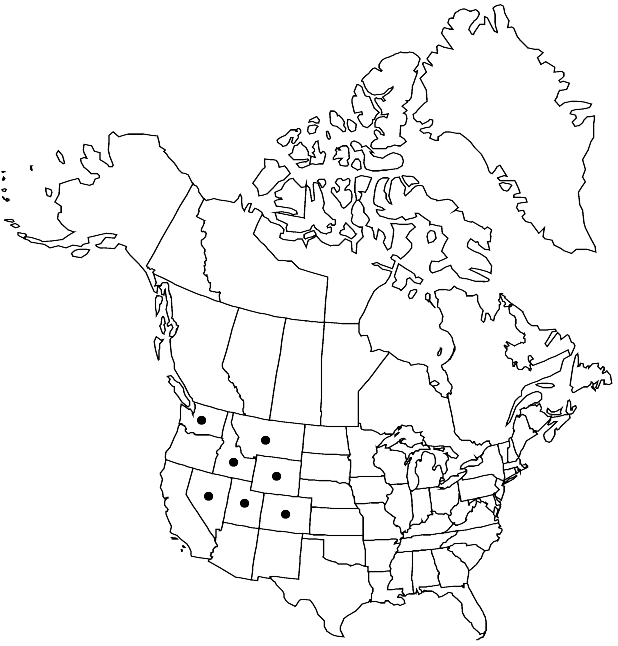Thelypodium sagittatum
in W. G. Walpers, Repert. Bot. Syst. 1: 172. 1842.
Biennials or perennials; (short-lived); sometimes glaucous, glabrous throughout or sparsely to densely pubescent. Stems branched often proximally and distally, (2–) 3–8 (–12.5) dm, (glabrous or pubescent). Basal leaves: petiole (1–) 2–8 (–14) cm, ciliate; blade usually oblanceolate to ovate, rarely oblong, (2–) 6.5–20 (–29) cm × 10–42 (–50) mm, margins entire, (surfaces glabrous or pubescent). Cauline leaves (ascending); sessile; blade lanceolate to oblong-lanceolate, (0.8–) 1.6–8.5 (–14) cm × 2–13 (–28) mm, (base amplexicaul to sagittate), margins entire, (surfaces glabrous or pubescent). Racemes sometimes corymbose, lax or dense, elongated or not in fruit, (flower buds ovate to lanceolate). Fruiting pedicels horizontal to divaricate, often curved upward, stout or slender, (2.5–) 3.5–11 (–20) mm, not flattened at base. Flowers: sepals erect, ovate to oblong, (2.5–) 3–6 (–10) × (1–) 1.5–2 (–2.5) mm; petals white or lavender to purple, oblanceolate to spatulate or linear, (5–) 7–14 (–19) × (0.5–) 1–3 (–4) mm, margins slightly crisped between blade and claw, claw differentiated from blade, [slender, (2–) 3–6.5 (–10) mm, narrowest at base]; nectar glands confluent and subtending bases of stamens, sometimes only lateral; filaments tetradynamous, median pairs 3–5.5 (–8) mm, lateral pair (2–) 2.5–4.5 (–7) mm; anthers included or partially exserted, oblong, (1.5–) 2–3.2 (–5) mm, not circinately coiled; gynophore (stout), 0.5–1 (–2) mm. Fruits erect, torulose, straight or slightly incurved (forming arc with pedicel), usually terete, rarely 4-angled, 1–5.3 (–6.9) cm × (0.5–) 0.8–1 (–1.2) mm; ovules 20–62per ovary; style cylindrical, 0.5–1.5 (–3.3) mm. Seeds (flattened), (0.7–) 1–1.3 (–1.5) × 0.5–0.7 (–1) mm.
Distribution

Colo., Idaho, Mont., Nev., Utah, Wash., Wyo.
Discussion
Subspecies 2 (2 in the flora).
Selected References
None.
Key
| 1 | Racemes often dense; fruiting pedicels 5-11(-20) mm; petals spatulate to oblanceolate, 1-3(-4) mm wide; median nectar glands often absent. | Thelypodium sagittatum subsp. sagittatum |
| 1 | Racemes lax; fruiting pedicels (2.5-)3.5-7(-8) mm; petals linear to linear-oblanceolate, 0.5-1 (-1.5) mm wide; median nectar glands present. | Thelypodium sagittatum subsp. ovalifolium |
"not" is not a number. "elongated" is not a number."thick" is not a number."dm" is not declared as a valid unit of measurement for this property."dm" is not declared as a valid unit of measurement for this property.